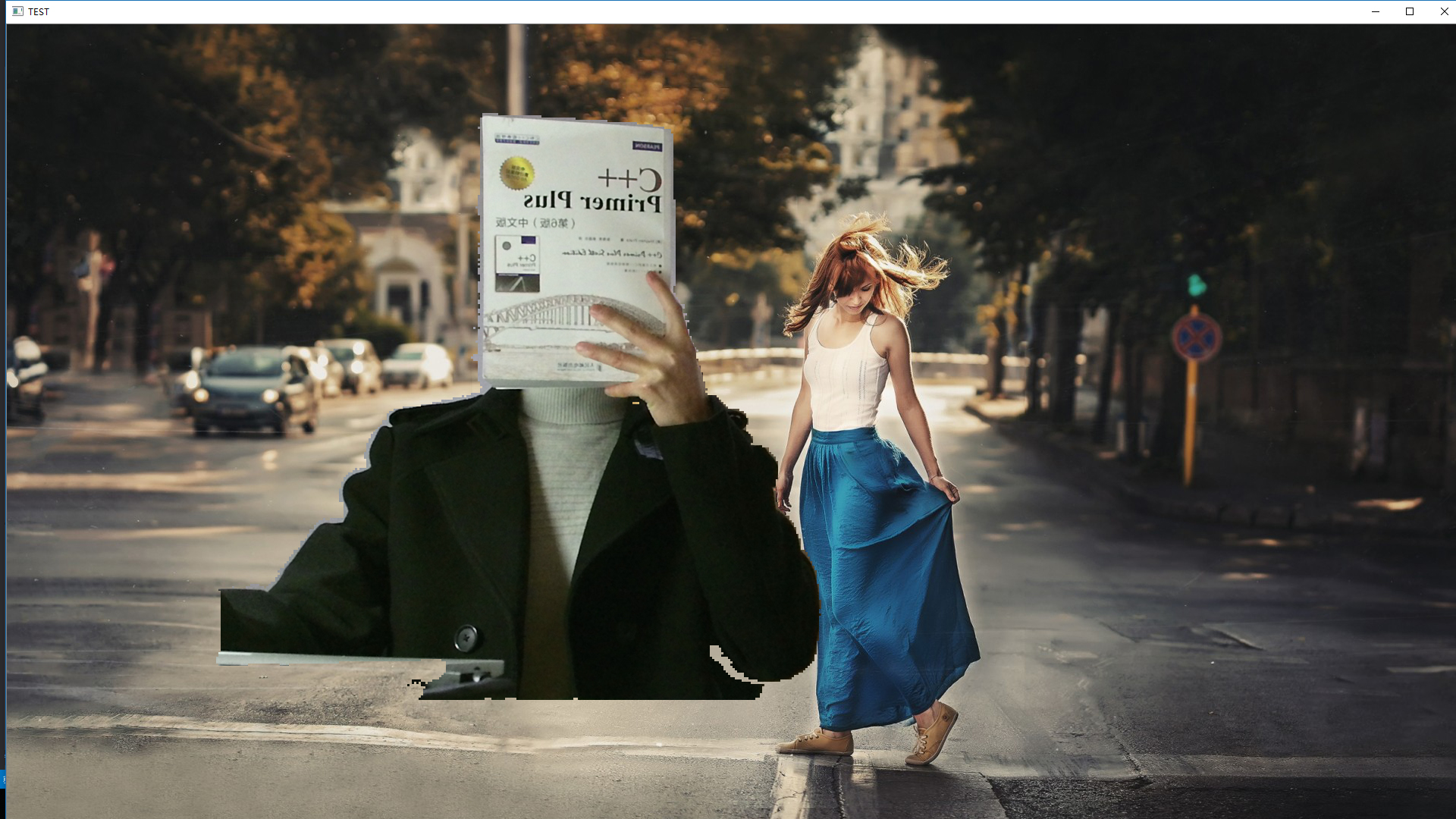上一篇里讲到了Kinect可以从环境中区分出人体来。因此可以利用这个功能,来把摄像头前的人合成进照片里,和利用Photoshop不同的是,这样合成进去的人是动态且实时的。
简单的思路
BodyIndex用的是深度数据,只能用来判断画面中的点属不属于人体而不能用来直接显示画面,Color图里的数据只能用来显示而没有其他功能。所以如果深度数据能和彩色数据配合的话,就能利用深度数据来识别出彩色数据中的哪些点属于人体。但是深度帧的分辨率是512 x 424,而彩色帧的分辨率是1920 x 1080 ,无法将他们对应起来。然而微软提供了一个叫ICoordinateMapper的类。
简单来说:将彩色图上的点转换到深度图的坐标系中->判断某点是否是人体->是的话从彩色图中取出此点,与背景替换。
代码
//这份代码累死哥了
#include <iostream>
#include <opencv2/imgproc.hpp>
#include <opencv2highgui.hpp>
#include <Kinect.h>
using namespace std;
using namespace cv;
int main(void)
{
IKinectSensor * mySensor = nullptr;
GetDefaultKinectSensor(&mySensor);
mySensor->Open();
//************************准备好彩色图像的Reader并获取尺寸*******************************
int colorHeight = 0, colorWidth = 0;
IColorFrameSource * myColorSource = nullptr;
IColorFrameReader * myColorReader = nullptr;
IFrameDescription * myDescription = nullptr;
{
mySensor->get_ColorFrameSource(&myColorSource);
myColorSource->OpenReader(&myColorReader);
myColorSource->get_FrameDescription(&myDescription);
myDescription->get_Height(&colorHeight);
myDescription->get_Width(&colorWidth);
myDescription->Release();
myColorSource->Release();
}
//************************准备好深度图像的Reader并获取尺寸*******************************
int depthHeight = 0, depthWidth = 0;
IDepthFrameSource * myDepthSource = nullptr;
IDepthFrameReader * myDepthReader = nullptr;
{
mySensor->get_DepthFrameSource(&myDepthSource);
myDepthSource->OpenReader(&myDepthReader);
myDepthSource->get_FrameDescription(&myDescription);
myDescription->get_Height(&depthHeight);
myDescription->get_Width(&depthWidth);
myDescription->Release();
myDepthSource->Release();
}
//************************准备好人体索引图像的Reader并获取尺寸****************************
int bodyHeight = 0, bodyWidth = 0;
IBodyIndexFrameSource * myBodyIndexSource = nullptr;
IBodyIndexFrameReader * myBodyIndexReader = nullptr;
{
mySensor->get_BodyIndexFrameSource(&myBodyIndexSource);
myBodyIndexSource->OpenReader(&myBodyIndexReader);
myDepthSource->get_FrameDescription(&myDescription);
myDescription->get_Height(&bodyHeight);
myDescription->get_Width(&bodyWidth);
myDescription->Release();
myBodyIndexSource->Release();
}
//************************为各种图像准备buffer,并且开启Mapper*****************************
UINT colorDataSize = colorHeight * colorWidth;
UINT depthDataSize = depthHeight * depthWidth;
UINT bodyDataSize = bodyHeight * bodyWidth;
Mat temp = imread("test.jpg"),background; //获取背景图
resize(temp,background,Size(colorWidth,colorHeight)); //调整至彩色图像的大小
ICoordinateMapper * myMaper = nullptr; //开启mapper
mySensor->get_CoordinateMapper(&myMaper);
Mat colorData(colorHeight, colorWidth, CV_8UC4); //准备buffer
UINT16 * depthData = new UINT16[depthDataSize];
BYTE * bodyData = new BYTE[bodyDataSize];
DepthSpacePoint * output = new DepthSpacePoint[colorDataSize];
//************************把各种图像读进buffer里,然后进行处理*****************************
while (1)
{
IColorFrame * myColorFrame = nullptr;
while (myColorReader->AcquireLatestFrame(&myColorFrame) != S_OK); //读取color图
myColorFrame->CopyConvertedFrameDataToArray(colorDataSize * 4, colorData.data, ColorImageFormat_Bgra);
myColorFrame->Release();
IDepthFrame * myDepthframe = nullptr;
while (myDepthReader->AcquireLatestFrame(&myDepthframe) != S_OK); //读取depth图
myDepthframe->CopyFrameDataToArray(depthDataSize, depthData);
myDepthframe->Release();
IBodyIndexFrame * myBodyIndexFrame = nullptr; //读取BodyIndex图
while (myBodyIndexReader->AcquireLatestFrame(&myBodyIndexFrame) != S_OK);
myBodyIndexFrame->CopyFrameDataToArray(bodyDataSize, bodyData);
myBodyIndexFrame->Release();
Mat copy = background.clone(); //复制一份背景图来做处理
if (myMaper->MapColorFrameToDepthSpace(depthDataSize, depthData, colorDataSize, output) == S_OK)
{
for (int i = 0; i < colorHeight; ++ i)
for (int j = 0; j < colorWidth;++ j)
{
DepthSpacePoint tPoint = output[i * colorWidth + j]; //取得彩色图像上的一点,此点包含了它对应到深度图上的坐标
if (tPoint.X >= 0 && tPoint.X < depthWidth && tPoint.Y >= 0 && tPoint.Y < depthHeight) //判断是否合法
{
int index = (int)tPoint.Y * depthWidth + (int)tPoint.X; //取得彩色图上那点对应在BodyIndex里的值(注意要强转)
if (bodyData[index] <= 5) //如果判断出彩色图上某点是人体,就用它来替换背景图上对应的点
{
Vec4b color = colorData.at<Vec4b>(i, j);
copy.at<Vec3b>(i, j) = Vec3b(color[0], color[1], color[2]);
}
}
}
imshow("TEST",copy);
}
if (waitKey(30) == VK_ESCAPE)
break;
}
delete[] depthData; //记得各种释放
delete[] bodyData;
delete[] output;
myMaper->Release();
myColorReader->Release();
myDepthReader->Release();
myBodyIndexReader->Release();
mySensor->Close();
mySensor->Release();
return 0;
}
详细说明:
SDK中提供了一个叫ICoordinateMapper的类,功能就是坐标系之间的互相转换,用来解决数据源的分辨率不同导致点对应不起来的问题。我们需要的是将彩色图像中的点与深度图像中的点一一对应起来,因此使用其中的MapColorFrameToDepthSpace()这个函数。
首选,需要准备好三种数据源:Color、BodyIndex、Depth,其中前两个是完成功能本来就需要的,第三个是转换坐标系时需要,无法直接把Color的坐标系映射到BodyIndex中,只能映射到Depth中。
然后是读取背景图,读取之后也要转换成Color图的尺寸,这样把Color中的点贴过去时坐标就不用再转换,直接替换就行。接下来也要读取三种Frame,为了易读性,不如把准备工作在前面都做完,在这一步直接用Reader就行。
然后,利用MapColorFrameToDepthSpace(),将彩色帧映射到深度坐标系,它需要4个参数,第1个是深度帧的大小,第2个是深度数据,第3个是彩色帧的大小,第4个是一个DepthSpacePoint的数组,它用来储存彩色空间中的每个点对应到深度空间的坐标。
要注意,这个函数只是完成坐标系的转换,也就是说它对于彩色坐标系中的每个点,都给出了一个此点对应到深度坐标系中的坐标,并不涉及到具体的ColorFrame。
最后,遍历彩色图像,对于每一点,都取出它对应的深度坐标系的坐标,然后把这个坐标放入BodyIndex的数据中,判断此点是否属于人体,如果属于,就把这点从彩色图中取出,跟背景图中同一坐标的点替换。
要注意的是,DepthSpacePoint中的X和Y的值都是float的,用它们来计算在BodyIndex里的坐标时,需要强转成int,不然画面就会不干净,一些不属于人体的地方也被标记成了人体被替换掉。
效果图
背景为一张1920 * 1080的壁纸
